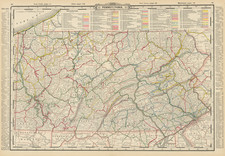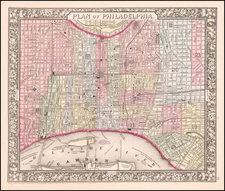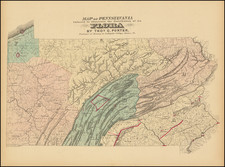Fine example of William Faden's important early chart of the Delaware River, prepared on the eve of the American Revolutionary War.
Fadens chart is the earliest obtainable derivative of Joshua Fisher's virtually unobtainable map, which has been referred to as the "most important Philadelphia-vicinity plan" -- Snyder.
In 1756, Joshua Fisher published in Philadelphia his Chart of Delaware Bay from the Sea-Coast to Reedy-Island. The chart, published during the French & Indian War, was immediately suppressed by the Assembly, fearing that its falling into enemy hands would make Philadelphia a target of the French navy. Before being ordered to stop selling the map, Fisher had in fact distributed a few copies, writing to Richard Peters in March 1756, "some few have been delivered, before notice, as also some few sent to England." Apparently, one of the latter (or perhaps an equally rare Philadelphia second edition of circa 1775) would eventually find its way to William Faden, who would re-engrave the map and issue it in March 1776 on the eve of the Revolution.
Fisher's chart shows the lower part of the bay and was intended to be used as a navigational aid for ships sailing toward Philadelphia. In 1775, Fisher produced an expanded chart that showed the bay and the Delaware River to just beyond Philadelphia. This was the most important map of the bay and river in the 18th century.
The map is oriented to the west so that Philadelphia lies at the far right, and Cape Henlopen at the far left. Navigational information is copious in the bay, and the main shipping lane is indicated to Philadelphia, with depths indicated along it. A list of Pilots and Masters of Vessels attesting to the accuracy of the chart are included.
Faden's edition of the map is earliest of the full size English editions of the chart, the Philadelphia edition being unobtainable to most collectors. Later editions would be issued by Dury and Sayer & Bennett.
William Faden (1749-1836) was the most prominent London mapmaker and publisher of the late-eighteenth and early-nineteenth centuries. His father, William Mackfaden, was a printer who dropped the first part of his last name due to the Jacobite rising of 1745.
Apprenticed to an engraver in the Clothworkers' Company, he was made free of the Company in August of 1771. He entered into a partnership with the family of Thomas Jeffreys, a prolific and well-respected mapmaker who had recently died in 1771. This partnership lasted until 1776.
Also in 1776, Faden joined the Society of Civil Engineers, which later changed its name to the Smeatonian Society of Civil Engineers. The Smeatonians operated as an elite, yet practical, dining club and his membership led Faden to several engineering publications, including canal plans and plans of other new engineering projects.
Faden's star rose during the American Revolution, when he produced popular maps and atlases focused on the American colonies and the battles that raged within them. In 1783, just as the war ended, Faden inherited his father's estate, allowing him to fully control his business and expand it; in the same year he gained the title "Geographer in Ordinary to his Majesty."
Faden also commanded a large stock of British county maps, which made him attractive as a partner to the Ordnance Survey; he published the first Ordnance map in 1801, a map of Kent. The Admiralty also admired his work and acquired some of his plates which were re-issued as official naval charts.
Faden was renowned for his ingenuity as well as his business acumen. In 1796 he was awarded a gold medal by the Society of Arts. With his brother-in-law, the astronomer and painter John Russell, he created the first extant lunar globe.
After retiring in 1823 the lucrative business passed to James Wyld, a former apprentice. He died in Shepperton in 1826, leaving a large estate.











![[Right sheet only of: A New Chart of America Florida to New York with the Principal Harbours on a Large Scale, Drawn from the latest Authorities, by Robt Blachford. 1807.]](https://storage.googleapis.com/raremaps/img/small/55819.jpg)

![[St. Helena] The True Description of the Island of Ascention lyeing under 8 degrees on ye South syde of ye Equinoctiall lyne.](https://storage.googleapis.com/raremaps/img/small/78964.jpg)
![[ First Postal Map of Pennsylvania & New Jersey ] Map of New Jersey and Pennsylvania Exhibiting the Post Offices, Post Roads, Canals, Rail Roads, & c.](https://storage.googleapis.com/raremaps/img/small/103212.jpg)